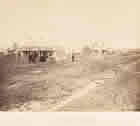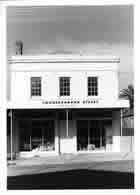In the beginning, business was rudimentary on the goldfields. Stores were typically tents, sometimes with the addition of rough slab walls and a mud chimney. Carcasses awash with flies hung from crude butcher’s set-ups – or ‘shambles’, as S.T. Gill labelled them in one sketch. Other traders, including many butchers, dispensed with the idea of a store and hawked their goods around the diggings. Often one tradesman would fulfil a number of roles – for instance, at Ballarat John Sharkey was a storekeeper, blacksmith, and butcher. Like the diggers, in the early days most merchants were itinerant – following their customers to the next rush.
Despite their primitive set-up, general stores could stock an amazing array of goods. Ellen Clacy, in 1852, described shops on the diggings as places where ‘everything required by a digger can be obtained for money, from sugar-candy to potted anchovies; from East India pickles to Bass’s pale ale.’ Antoine Fauchery painted a bleaker picture, suggesting that the difficulties involved in transporting goods to the diggings meant well-stocked stores could not be relied upon: ‘When drays failed to arrive, nothing [was] left in the stores but boots or saucepans.’
Business on the goldfields was a transitory, speculative venture. Captive customers meant storekeepers could afford high mark-ups – ‘There is one principle they have adopted and adhered to with the greatest uniformity’ complained Alec Finlay of storekeepers, ‘and that is extortion’ – but ordering supplies and timing deliveries was a risky business. A well-stocked store could bring its proprietor a fortune if a rush in an area lasted or grew. Equally, those stuck with piles of expensive stock just as there was a rush away from a field would be ruined. Still, contemporaries like Clacy observed that it was less speculative than gold and that merchants and tradesmen ‘usually in the long run make a fortune quicker than diggers and certainly with less hard work.’ Historian Geoffrey Blainey has argued that butchers (the only food sellers who could rely exclusively on local produce) were often particularly prosperous: ‘If we were able to piece together a list of the hundred men who in the 1850s made the most money from the gold-fields,’ he wrote, ‘butchers would probably predominate.’
Historian Weston Bate has pointed out that stores on the diggings not only delivered fortunes to some lucky tenders, and goods to the diggers, but also served as postal depots and landmarks. As sketches of the goldfields illustrate, distinctive flags fluttering on long poles, providing clear, if temporary, points of reference in the landscape, characteristically distinguished them. Mail, visitors, and new chums to the goldfields might thus be directed to their destination ‘c/o this or that store.’ In places where there was sustained mining activity, such landmarks could quickly become establishments, and substantial towns often formed around a hub of successful tent-stores.





